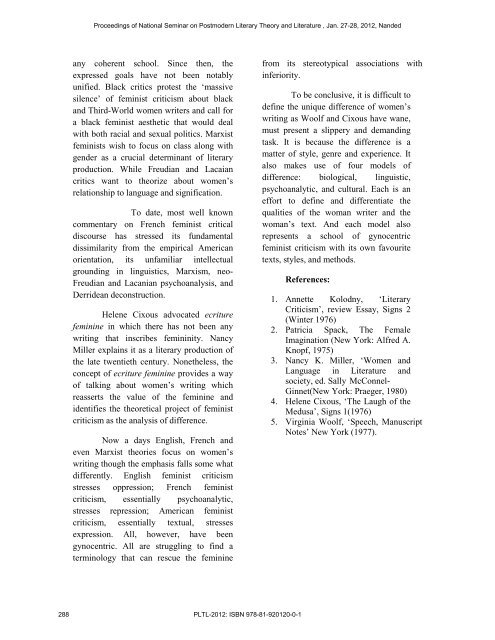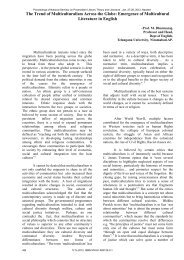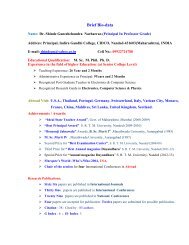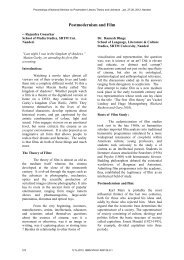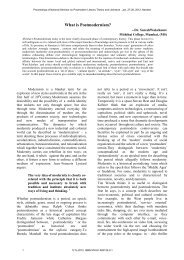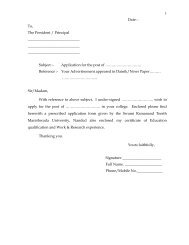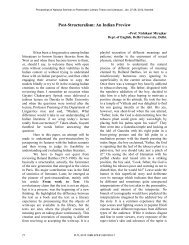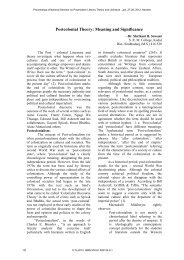Postcolonial Feminist Theory: An Overview - Igcollege.org
Postcolonial Feminist Theory: An Overview - Igcollege.org
Postcolonial Feminist Theory: An Overview - Igcollege.org
You also want an ePaper? Increase the reach of your titles
YUMPU automatically turns print PDFs into web optimized ePapers that Google loves.
Proceedings of National Seminar on Postmodern Literary <strong>Theory</strong> and Literature , Jan. 27-28, 2012, Nandedany coherent school. Since then, theexpressed goals have not been notablyunified. Black critics protest the ‘massivesilence’ of feminist criticism about blackand Third-World women writers and call fora black feminist aesthetic that would dealwith both racial and sexual politics. Marxistfeminists wish to focus on class along withgender as a crucial determinant of literaryproduction. While Freudian and Lacaiancritics want to theorize about women’srelationship to language and signification.To date, most well knowncommentary on French feminist criticaldiscourse has stressed its fundamentaldissimilarity from the empirical Americanorientation, its unfamiliar intellectualgrounding in linguistics, Marxism, neo-Freudian and Lacanian psychoanalysis, andDerridean deconstruction.Helene Cixous advocated ecriturefeminine in which there has not been anywriting that inscribes femininity. NancyMiller explains it as a literary production ofthe late twentieth century. Nonetheless, theconcept of ecriture feminine provides a wayof talking about women’s writing whichreasserts the value of the feminine andidentifies the theoretical project of feministcriticism as the analysis of difference.Now a days English, French andeven Marxist theories focus on women’swriting though the emphasis falls some whatdifferently. English feminist criticismstresses oppression; French feministcriticism, essentially psychoanalytic,stresses repression; American feministcriticism, essentially textual, stressesexpression. All, however, have beengynocentric. All are struggling to find aterminology that can rescue the femininefrom its stereotypical associations withinferiority.To be conclusive, it is difficult todefine the unique difference of women’swriting as Woolf and Cixous have wane,must present a slippery and demandingtask. It is because the difference is amatter of style, genre and experience. Italso makes use of four models ofdifference: biological, linguistic,psychoanalytic, and cultural. Each is aneffort to define and differentiate thequalities of the woman writer and thewoman’s text. <strong>An</strong>d each model alsorepresents a school of gynocentricfeminist criticism with its own favouritetexts, styles, and methods.References:1. <strong>An</strong>nette Kolodny, ‘LiteraryCriticism’, review Essay, Signs 2(Winter 1976)2. Patricia Spack, The FemaleImagination (New York: Alfred A.Knopf, 1975)3. Nancy K. Miller, ‘Women andLanguage in Literature andsociety, ed. Sally McConnel-Ginnet(New York: Praeger, 1980)4. Helene Cixous, ‘The Laugh of theMedusa’, Signs 1(1976)5. Virginia Woolf, ‘Speech, ManuscriptNotes’ New York (1977).288 PLTL-2012: ISBN 978-81-920120-0-1


